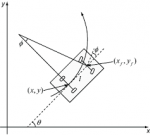Hello,
Maybe you have heard of it, or maybe not : ROS (robot operating system: https://www.ros.org/) - I wonder if this could be an interesting (experimental and also end-user) software platform for the Ardumower. I'm not talking about hardware here (that can be solved quickly, so please do not talk about hardware here) - I'm talking about software here and specifically which ROS software components could be useful for an Ardumower.
So what are the ROS concepts?
So, which ROS modules (ROS melodic) could be useful for an Ardumower?
localization (sensors and sensor fusion):
coverage planning:
path planning:
You probably have found more interesting ROS modules! Feel free to post further ideas for ROS components that could be useful for an Ardumower and that should be tried out when starting real-world ROS experiments (additional ROS modules for interesting sensors, sensor fusion, localization, coverage planning, path planning, etc.).
Happy Ardumowing!
Regards,
Alexander
Maybe you have heard of it, or maybe not : ROS (robot operating system: https://www.ros.org/) - I wonder if this could be an interesting (experimental and also end-user) software platform for the Ardumower. I'm not talking about hardware here (that can be solved quickly, so please do not talk about hardware here) - I'm talking about software here and specifically which ROS software components could be useful for an Ardumower.
So what are the ROS concepts?
- localization : 'localization' is the process of estimating the position (X, Y) and orientation (delta) of the robot on the ground based on one or more sensors and sensor fusion (if more sensors are used)

- robot kinematic model : a 'kinematic model' describes the robot's dimensions and its control point (the point that describes the position of the robot and how that point can actually move based on the robot's kinematic model and dimensions)

- coverage planning : the 'coverage planner' plans all the waypoints based on the given perimeter and exclusions

- path planning : the 'path planner' plans the trajectory to get to the next waypoint and considers the robot's kinematic (dimensions and control point), dynamic obstacles, fixed obstacles and other contraints like speed

So, which ROS modules (ROS melodic) could be useful for an Ardumower?
localization (sensors and sensor fusion):
- ublox_f9p ( RTK GPS, https://github.com/ros-agriculture/ublox_f9p )
- realsense-ros (visual SLAM tracking camera, https://github.com/IntelRealSense/realsense-ros )
- robot_localization ( https://github.com/Greenzie/robot_localization )
- sf-pkg ( https://github.com/tuw-cpsg/sf-pkg )
- VINS-Fusion ( https://github.com/HKUST-Aerial-Robotics/VINS-Fusion )
coverage planning:
- boustrophedon_planner ( https://github.com/Greenzie/boustrophedon_planner )
- full_coverage_path_planner ( https://github.com/nobleo/full_coverage_path_planner , https://www.rosin-project.eu/ftp/coverage-path-planning-and-control )
path planning:
- teb_local_planner ( https://github.com/rst-tu-dortmund/teb_local_planner )
You probably have found more interesting ROS modules! Feel free to post further ideas for ROS components that could be useful for an Ardumower and that should be tried out when starting real-world ROS experiments (additional ROS modules for interesting sensors, sensor fusion, localization, coverage planning, path planning, etc.).
Happy Ardumowing!
Regards,
Alexander
Zuletzt bearbeitet: